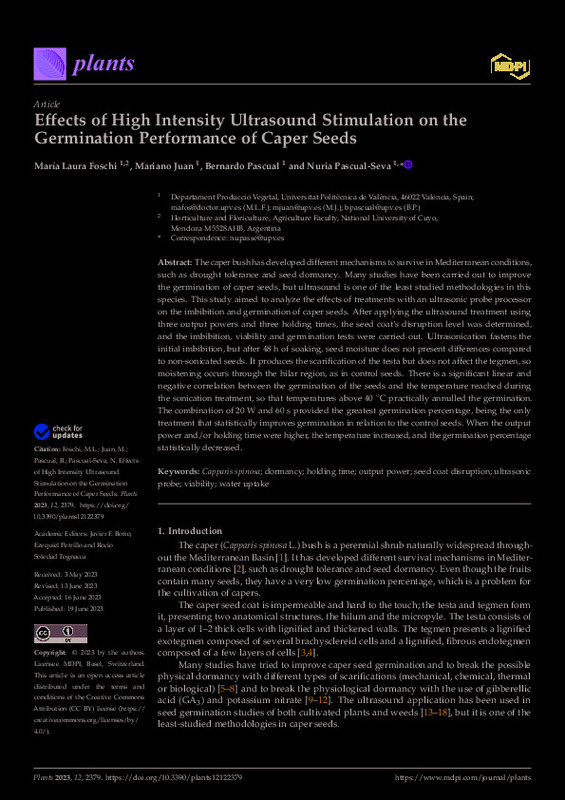JavaScript is disabled for your browser. Some features of this site may not work without it.
Buscar en RiuNet
Listar
Mi cuenta
Estadísticas
Ayuda RiuNet
Admin. UPV
Effects of High Intensity Ultrasound Stimulation on the Germination Performance of Caper Seeds
Mostrar el registro sencillo del ítem
Ficheros en el ítem
| dc.contributor.author | Foschi, María Laura
|
es_ES |
| dc.contributor.author | Juan Ferrer, Mariano
|
es_ES |
| dc.contributor.author | Pascual España, Bernardo
|
es_ES |
| dc.contributor.author | Pascual-Seva, Nuria
|
es_ES |
| dc.date.accessioned | 2024-02-08T08:26:09Z | |
| dc.date.available | 2024-02-08T08:26:09Z | |
| dc.date.issued | 2023-06 | es_ES |
| dc.identifier.uri | http://hdl.handle.net/10251/202420 | |
| dc.description.abstract | [EN] The caper bush has developed different mechanisms to survive in Mediterranean conditions, such as drought tolerance and seed dormancy. Many studies have been carried out to improve the germination of caper seeds, but ultrasound is one of the least studied methodologies in this species. This study aimed to analyze the effects of treatments with an ultrasonic probe processor on the imbibition and germination of caper seeds. After applying the ultrasound treatment using three output powers and three holding times, the seed coat's disruption level was determined, and the imbibition, viability and germination tests were carried out. Ultrasonication fastens the initial imbibition, but after 48 h of soaking, seed moisture does not present differences compared to non-sonicated seeds. It produces the scarification of the testa but does not affect the tegmen, so moistening occurs through the hilar region, as in control seeds. There is a significant linear and negative correlation between the germination of the seeds and the temperature reached during the sonication treatment, so that temperatures above 40 & DEG;C practically annulled the germination. The combination of 20 W and 60 s provided the greatest germination percentage, being the only treatment that statistically improves germination in relation to the control seeds. When the output power and/or holding time were higher, the temperature increased, and the germination percentage statistically decreased. | es_ES |
| dc.language | Inglés | es_ES |
| dc.publisher | MDPI | es_ES |
| dc.relation.ispartof | Plants | es_ES |
| dc.rights | Reconocimiento (by) | es_ES |
| dc.subject | Capparis spinosa | es_ES |
| dc.subject | Dormancy | es_ES |
| dc.subject | Holding time | es_ES |
| dc.subject | Output power | es_ES |
| dc.subject | Seed coat disruption | es_ES |
| dc.subject | Ultrasonic probe | es_ES |
| dc.subject | Viability | es_ES |
| dc.subject | Water uptake | es_ES |
| dc.subject.classification | PRODUCCION VEGETAL | es_ES |
| dc.title | Effects of High Intensity Ultrasound Stimulation on the Germination Performance of Caper Seeds | es_ES |
| dc.type | Artículo | es_ES |
| dc.identifier.doi | 10.3390/plants12122379 | es_ES |
| dc.rights.accessRights | Abierto | es_ES |
| dc.contributor.affiliation | Universitat Politècnica de València. Escuela Técnica Superior de Ingeniería Agronómica y del Medio Natural - Escola Tècnica Superior d'Enginyeria Agronòmica i del Medi Natural | es_ES |
| dc.description.bibliographicCitation | Foschi, ML.; Juan Ferrer, M.; Pascual España, B.; Pascual-Seva, N. (2023). Effects of High Intensity Ultrasound Stimulation on the Germination Performance of Caper Seeds. Plants. 12(12). https://doi.org/10.3390/plants12122379 | es_ES |
| dc.description.accrualMethod | S | es_ES |
| dc.relation.publisherversion | https://doi.org/10.3390/plants12122379 | es_ES |
| dc.type.version | info:eu-repo/semantics/publishedVersion | es_ES |
| dc.description.volume | 12 | es_ES |
| dc.description.issue | 12 | es_ES |
| dc.identifier.eissn | 2223-7747 | es_ES |
| dc.identifier.pmid | 37376004 | es_ES |
| dc.identifier.pmcid | PMC10302670 | es_ES |
| dc.relation.pasarela | S\497329 | es_ES |
| dc.contributor.funder | Universitat Politècnica de València | |
| dc.subject.ods | 12.- Garantizar las pautas de consumo y de producción sostenibles | es_ES |








